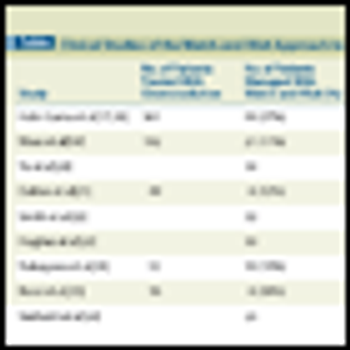
There are a number of clinicopathologic variables that predict outcome in rectal cancer. In the era of postoperative chemoradiation treatment, these were more easily identified and were used to help select patients for adjuvant therapy.

Your AI-Trained Oncology Knowledge Connection!


There are a number of clinicopathologic variables that predict outcome in rectal cancer. In the era of postoperative chemoradiation treatment, these were more easily identified and were used to help select patients for adjuvant therapy.

This article reviews current evidence in support of a watch-and-wait approach to rectal cancer management, and discusses the challenges and limitations of this approach.

As with any legislation, there are both positive and negative aspects. Specific to oncology, one of the greatest impacts of the ACA will be the move to a bundled payment for a treatment of a disease.

Treatment for patients with locally advanced, resectable rectal cancer has clearly evolved, with significant refinements in preoperative assessment, surgical technique, and use of preoperative chemoradiation.

Since the early 1990s, postoperative adjuvant chemoradiotherapy was widely viewed as the main approach to treat patients with stage II and III rectal cancer. Over the past few years, significant efforts have shifted towards developing neoadjuvant approaches, which combine chemotherapy with radiotherapy prior to surgical resection.

Prior to the publication of the German CAO/ARO/AIO 94 trial, the conventional adjuvant approach for patients with clinically resectable, ultrasonographically diagnosed T3 (uT3) and/or node-positive rectal cancer was initial surgery and, if pathologically confirmed T3 (pT3) and/or node-positive, postoperative combined chemotherapy plus radiation. The German trial confirmed that compared to postoperative therapy, the preoperative approach was associated with significantly lower local recurrence rates, less acute and chronic toxicity, and an increased incidence of sphincter preservation.

Epidermal growth factor receptor (EGFR) and vascular endothelial growth factor (VEGF) are often overexpressed in colorectal cancer and are associated with inferior outcomes. Based on successful randomized phase III trials, anti-EGFR and anti-VEGF therapeutics have entered clinical practice. Cetuximab (Erbitux), an EGFR-specific antibody, is currently approved in the United States in combination with irinotecan (Camptosar) for patients with metastatic colorectal cancer refractory to irinotecan or as a single agent for patients unable to tolerate irinotecan-based therapy. In retrospective analyses, patients with EGFR-expressing rectal cancer undergoing neoadjuvant radiation therapy had a significantly inferior disease-free survival and lower rates of achieving pathologic complete response. Based on the positive data in metastatic colorectal cancer and synergy with radiation therapy seen in preclinical models, there is a strong rationale to combine cetuximab with neoadjuvant radiation therapy and chemotherapy in rectal cancer. Bevacizumab (Avastin), a VEGF-specific antibody, was the first antiangiogenic agent to be approved in the United States for use in combination with standard chemotherapy in the first- and second-line of treatment in metastatic colorectal cancer. VEGF-targeted therapy may lead to indirect killing of cancer cells by damaging tumor blood vessels, and may increase the radiosensitivity of tumor-associated endothelial cells. VEGF blockade can also "normalize" tumor vasculature, thereby leading to greater tumor oxygenation and drug penetration. This review will address completed and ongoing trials that have established and continue to clarify the effects of these agents in rectal cancer.

Based on positive results from the Radiation Therapy Oncology Group (RTOG) 85-01 trial, the conventional nonsurgical treatment of esophageal carcinoma is combined-modality therapy. Dose intensification of the RTOG 85-01 regimen, examined in the Intergroup (INT)-0123/RTOG 94-05 trial, did not improve local control or survival. Areas of clinical investigation include the development of combined-modality therapy regimens with newer systemic agents, the use of 18F-fluorodeoxyglucose positron-emission tomography to assist in the development of innovative radiation treatment planning techniques, and the identification of prognostic molecular markers. The addition of surgery following primary combined-modality therapy apparently does not improve survival, but this finding is controversial.

Colon cancer is a major public health problem. The primary treatment is resection. For patients with early-stage disease, surgery results in excellent survival rates. In contrast, patients with locally advanced tumors arising in "anatomically immobile" segments of large bowel have a less satisfactory outcome, in part secondary to compromised surgical clearance. Patterns-of-failure analyses suggest that for tumors that invade adjacent organs, exhibit perforation or fistula, or are subtotally resected, local failure rates exceed 30%. Multiple single-institution retrospective studies have shown improved local control and possibly survival with the addition of external irradiation and/or intraoperative radiation. In contrast, a recent Intergroup trial failed to show any benefit by the addition of adjuvant radiation therapy combined with chemotherapy. Interpretation of this trial's results is handicapped by low patient accrual. With the advent of novel and more effective systemic therapies for metastatic colon cancer, current and future clinical research will address the efficacy of these agents in the adjuvant setting. Adjuvant radiation therapy should be considered in patients with colon cancer at high risk for local failure.

There are two conventional treatments for clinically resectable rectalcancer. The first is surgery followed by postoperative combinedmodalitytherapy if the tumor is T3 and/or N1/2. The second, if thetumor is ultrasound T3 or clinical T4, is preoperative combined-modalitytherapy followed by surgery and postoperative chemotherapy. Thereare a number of new chemotherapeutic agents that have been developedfor the treatment of colorectal cancer. Phase I/II trials are examiningthe use of new chemotherapeutic agents in combination with pelvicradiation therapy, most commonly in the preoperative setting. Thereis considerable interest in integrating irinotecan (Camptosar) into preoperativecombined-modality therapy regimens for rectal cancer. Basedon these trials, the recommended regimen for patients who receiveirinotecan-based combined-modality therapy is continuous infusionfluorouracil (5-FU), irinotecan, and pelvic radiation. New trials examiningpreoperative combined-modality therapy regimens substitutingcapecitabine (Xeloda) for continuous infusion 5-FU are in progress.

The limited effectiveness of chemotherapy in esophageal cancerused to palliate metastatic disease or to combine with radiotherapy inlocally advanced disease has prompted the evaluation of new systemicagents. Irinotecan (CPT-11, Camptosar) has shown promising activityin a number of gastrointestinal cancers, including esophageal cancer.The phase II evaluation of the combination of weekly irinotecan andcisplatin has shown encouraging response rates exceeding 30% to 50%in esophageal and gastric cancer. Novel regimens include the combinationof irinotecan with mitomycin (Mutamycin), the taxanes docetaxel(Taxotere) and paclitaxel, and continuous infusion fluorouracil(5-FU). Irinotecan is an active radiosensitizer, and trials have evaluatedthe combination of irinotecan with concurrent radiotherapy. We completeda phase I trial combining weekly irinotecan, cisplatin, andconcurrent radiotherapy in locally advanced esophageal cancer. Minimaltoxicity has been observed, with no grade 3/4 esophagitis ordiarrhea, and hematologic toxicity was also surprisingly minimal. Fulldoses of weekly irinotecan (65 mg/m2) and cisplatin (30 mg/m2) could becombined safely with concurrent radiotherapy, with a significant rate ofpathologic complete response. Phase II evaluation of this chemoradiotherapyregimen as preoperative therapy is planned at single institutionsand at the cooperative group level in the United States. Furtherphase I and II investigation of combined irinotecan, cisplatin, andconcurrent radiation is ongoing with the addition of targeted agents,including celecoxib (Celebrex), cetuximab (Erbitux), and bevacizumab(Avastin). Alternative combinations of irinotecan with radiotherapy,including the addition of docetaxel and continuous infusion 5-FU, arealso undergoing phase I and II evaluation.

The limited effectiveness of currently available chemotherapy in the treatment of advanced esophageal cancer, and the poor survival achieved in locally advanced disease with combined chemoradiotherapy with or without surgery, have prompted the evaluation of new agents. Irinotecan (CPT-11, Camptosar) has promising single-agent activity in gastrointestinal cancers.

Preoperative or postoperative pelvic radiation plus concurrent fluorouracil-based chemotherapy is standard adjuvant treatment for patients with T3 and/or N1/2 rectal cancer. Newer chemotherapeutic regimens have been developed for the treatment of patients with metastatic disease.

The standard surgical treatment of distal, resectable, invasive rectal cancers is an abdominoperineal resection or a low anterior resection. Given the morbidity associated with these standard treatments and the frequent need

Postoperative combined-modality therapy with fluorouracil (5-FU) and radiation therapy is accepted practice for high-risk rectal cancer. Postoperative pelvic radiotherapy alone may improve pelvic control, but is not associated with an improvement in survival.

The two general treatment approaches for esophagel cancer are primary treatment (surgical or nonsurgical) or adjuvant treatment (preoperative or postoperative). Due to differences in the patient populations selected for surgical or nonsurgical therapies, which may bias the results against nonsurgical therapy, it is difficult to determine the best treatment approach for this disease. The standard of care is either surgery alone or primary combined-modality therapy. Based on a nonrandomized comparison of the data from recent intergroup trials, the results of these two approaches are similar. For patients treated without surgery, the intergroup INT 0123 trial will determine whether higher doses of radiation are of benefit. No clear survival advantage has been seen with preoperative or postoperative adjuvant radiation therapy alone or chemotherapy alone. The randomized trials comparing preoperative combined-modality therapy vs surgery alone reveal encouraging results for the combination approach but need further confirmation. For patients treated with combined-modality therapy, the ideal regimen remains to be determined. Part 1 of this two-part review, which appeared in last month’s issue, centered on primary therapy for esophageal carcinoma. This part explores the rationale for and results of adjuvant therapy. [ONCOLOGY 13(10):1415-1427,1999]

The two general treatment approaches for esophagel cancer include primary treatment (surgical or nonsurgical) or adjuvant treatment (preoperative or postoperative). Due to differences in the patient populations selected for

A number of advances have been made in the use of adjuvant chemotherapy for resectable rectal cancer. Whereas pelvic radiation therapy has been shown to increase local control in patients with clinically resectable

During the past decade, advances have been made in the adjuvant treatment of resectable rectal cancer. Postoperative combined-modality therapy significantly improves local control and survival. Recent Intergroup

Standard adjuvant therapy for transmural (T3) and/or node-positive rectal cancer is pelvic radiation therapy plus fluorouracil (5-FU)-based chemotherapy. Randomized trials are in progress to help determine the ideal

The standard adjuvant therapy for resectable T3 and/or N1-2 rectal cancer is pelvic radiation therapy plus fluorouracil (5-FU)-based chemotherapy. Two randomized intergroup trials, INT 0114 and INT 0144, will help

Blackstock and colleagues present a well-written, comprehensive review of the current state of management of both resectable and unresectable pancreatic carcinoma, as well as ongoing research and future strategies. Unfortunately, in the majority of patients, the disease is locally advanced at diagnosis, with or without regional and distant metastases. Unlike recent advances in screening for both prostate and breast cancer, no reliable and/or cost-effective method for identifying patients at risk for pancreatic cancer is available. Also, there is currently no reliable hematologic marker that can identify patients whose cancers are in the earliest developmental stage. Blackstock et al do emphasize that recent advances in laparoscopic techniques have led to better selection of patients for subsequent exploration and surgical resection. Given the reduction in operative mortality during the last 10 years, survival rates have improved.

Published: August 1st 2007 | Updated:

Published: March 1st 1996 | Updated:

Published: June 29th 2012 | Updated:

Published: May 1st 2009 | Updated:

Published: November 16th 2008 | Updated:

Published: May 2nd 2002 | Updated: